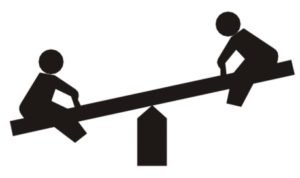By Donna Baver Rovito
(This blog originally appeared on the Pennsylvania Medical Society website under a slightly different title – https://www.pamedsoc.org/tools-you-can-use/topics/quality-and-value-blog/Mar916)
Hearing the word “balance,” always makes me flash to a scene from one of my favorite movies – The Karate Kid. I can clearly hear actor Pat Morita’s “broken” English (amazingly authentic considering that he was born in California).

(Watch it here: https://www.youtube.com/watch?v=QsPoBXemFmg)
“You remember lesson about balance?” he asks young protégé Daniel. “Lesson not just karate only. Lesson for all life. All life have balance – everything be better.”
Everything is better when we have balance. The issue in today’s busy, busy world – with its frenetic pace, smart phones, Internet and social media clamoring for our attention every hour of the day, constant change in medicine, work, family, home life and everything else – is how we can even begin to achieve that elusive ideal.
Finding that all-important balance is a skill. Fortunately, it’s a skill we can learn.
The Winter 2016 issue of Physician Family provides tools to help physician families find better work-life balance. Sara Taylor, MD, and Tracy Roth, MD, both members of two-physician families, have developed steps to achieve better balance in their lives:
1. Sort out what is important versus what is urgent. Don’t get caught up in the crisis of the moment.
2. Spend more time being and less time doing. Constant “busyness” detracts from what’s really important.
3. Say “No” more often. You don’t need to be in charge to be useful.

4. Prioritize self-care. Don’t skip this because you “don’t have time.” Get enough sleep and exercise. Do things that make you happy – it will give you the resources you need.
5. Track schedules and routines in whatever way works for your family: electronic, white board, paper calendar, etc.
6. Stay organized – don’t waste time and anxiety looking for “lost” things.

7. Make time for your partner/spouse, to stay connected and keep your relationship strong.
8. Learn how to ask for and accept help. You really can’t do everything yourself – and that’s OK.

Here’s the recurring message – balance is something we simply cannot achieve by ourselves. Just as you can’t possibly balance a seesaw on your own, achieving balance in our work and home lives isn’t a singular task.

While the seesaw may teeter from time to time, we’re more likely to reach that calming balanced state if we seek it together – whether “together” is as part of your own physician family, as part of whatever local communities matter to your family, or as part of the broader community of medicine, in organizations like the Pennsylvania Medical Society or a supportive physician family organization like the Pennsylvania Medical Society Alliance and the American Medical Association Alliance.
Seek out connections that make you stronger and help you to achieve balance – because “All life have balance – everything be better.”

Donna Baver Rovito is editor of Physician Family and has been balancing her physician family, with varying degrees of success, for 38 years. She and surgeon husband Peter have two sons, Peter and Tony. She attributes much of the balance in her life to her involvement with her local and state medical society Alliances and the AMA Alliance. (www.amaalliance.org)
Read the articles on which this blog was based!
4 Steps Toward Achieving Work/Life and Home/ Life Balance
by Sara Taylor, MD
http://www.bluetoad.com/publication/?i=287407&m&id=14636&p#{“issue_id”:287407,”page”:6}
and
Balancing a Two-Physician Family
By Tracy Roth, MD
http://www.bluetoad.com/publication/?i=287407&m&id=14636&p#{“issue_id”:287407,”page”:12}
